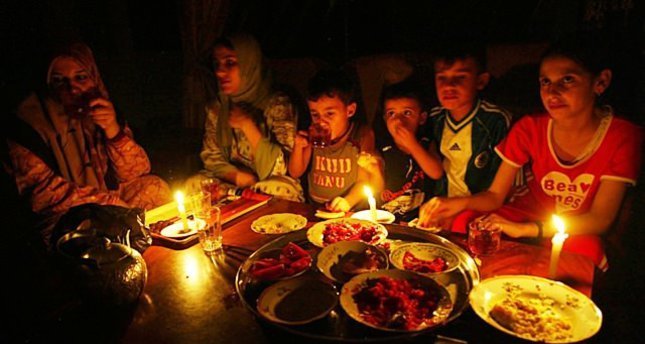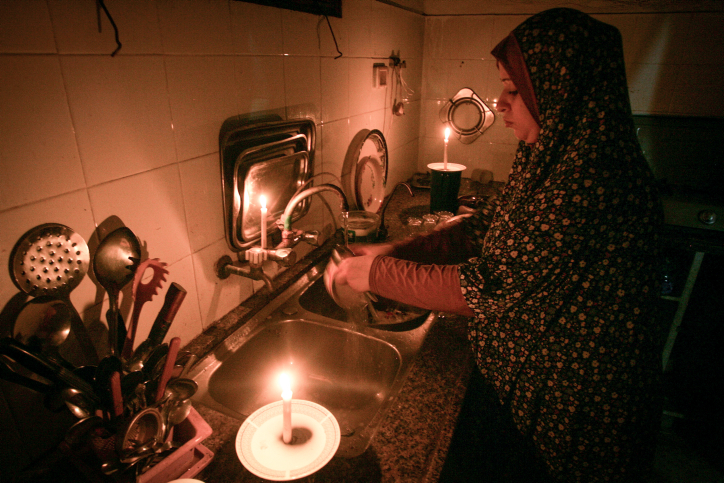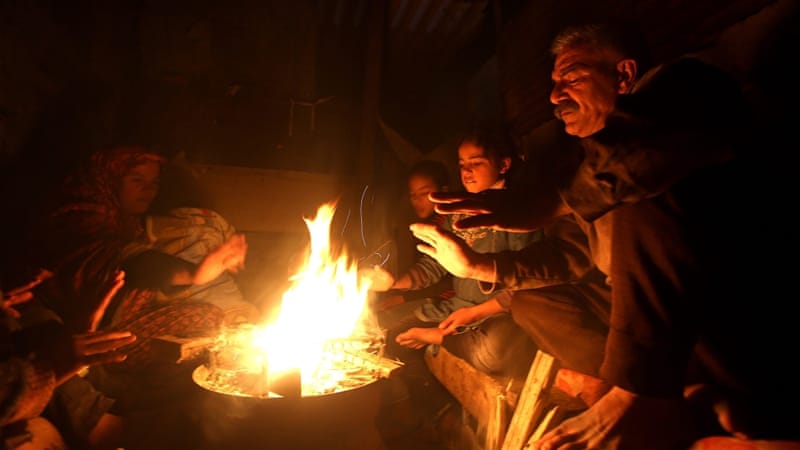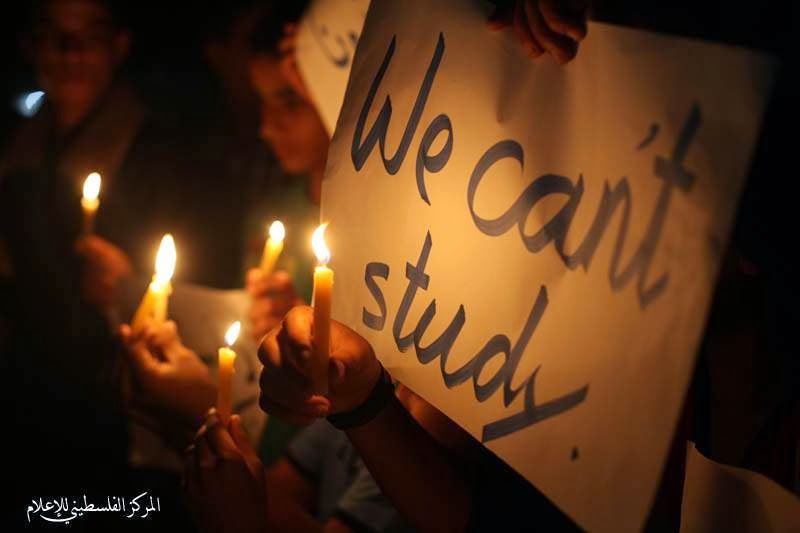
One of the defining characteristics of life in the Gaza Strip is a shortage of electricity, so essential for such basic functions as taking a hot shower, storing perishable foods, studying for school, and operating all manner of equipment and businesses—from hospitals to shops. In 2018, electricity was available in Gaza for an average of only five hours per day, dipping as low as four during the spring and summer months.
Here are the facts that explain the lack of such a vital, basic commodity:
What are the sources of Gaza’s electricity?
The primary players are:
- Israel, which allows the import of diesel fuel to run Gaza’s power plant as well as the direct purchase of electricity.
- Egypt, which sometimes sells its own electricity to residents in the southern area of Gaza.
- Qatar, whose government donated enough money to fund fuel purchases for six months beginning in November 2018.
- The two Palestinian political parties(Hamas and Fatah), which squabble over who should pay for fuel and electricity when no donor is available, as well as who should control any donations when they are received.
Gaza has one power plant, built in 2002, that produces electricity from diesel fuel imported from Israel via the Kerem Shalom crossing. (Although natural gas was discovered in 2000 in the sea off of Gaza’s coast, the blockade has prevented its development, thus necessitating purchase of fuel from Israel.)
The power plant was designed to produce 140 megawatts (MW) of electricity, primarily for the 50 percent of Gaza’s 2 million residents who live in and around Gaza City. However, it never provided that much due to the limited capacity of its relay network. In June 2006, for example, the power plant generated just 90 MW, with another 120 MW purchased from the Israel Electric Corp., paid for by the Palestinian Authority (PA) in the West Bank with European Union funds.
Later that year, however, Israel bombed the power plant for the first time, causing it to shut down. The Egyptian government stepped in to help, providing residents and businesses in the Rafah area of the Gaza Strip with 17 MW of electricity, also paid for by the PA—a role it has played off and on during the years since. Although the power plant reopened in December 2007, it was the beginning of a pattern of repeated shutdowns due to periodic bombings; a shortage of spare parts, which must be imported from Israeli or other foreign companies; and sporadic halts of fuel shipments by Israel.
Storage also is an issue. The power plant can store only enough fuel for about two and a half days of operations. A larger tank was shelled by Israel in 2014 and has not been repaired since. That means frequent shipments are necessary.

Another important development occurred at the end of 2009, when the European Union stopped funding the purchase of industrial diesel fuel for the power plant—triggering a dispute between Hamas, which governs Gaza, and Fatah, which dominates the PA in the West Bank, about who should pay for it. For a while, until the Egyptian military destroyed most of the tunnels in 2013-14, regular diesel fuel was smuggled into Gaza, greatly increasing pollution from sulfur emissions.
Today, an average of 120 MW of electricity is purchased from the Israeli power company and 30-75 MW are generated by Gaza’s power plant—leaving a significant gap of 200-415 MW, based on Gaza’s projected needs. Recently, the government of Qatar has become another important source of Gaza’s electricity: In November 2018, the Qatari government announced a donation of US$60 million for fuel, which the United Nations purchases from Israel and brings in to operate additional turbines at Gaza’s power plant. The Qatari donation is expected to be sufficient to operate three of the plant’s four turbines for six months, through April 2019. If nothing else changes, Gaza residents should receive electricity in cycles consisting of eight (or more) hours of power followed by about eight hours of blackout.
Who is at fault?
The Israeli government is the occupying power, controlling all vital aspects of life in Gaza—from registration for ID cards, to the money system, to trade, to travel in and out. Thus, the Israeli government bears the ultimate responsibility for the chronic electricity shortages.
However, the crisis is exacerbated by the internal dispute between Hamas and Fatah. InJune2017, for example, PA President Mahmoud Abbas and Hussein al-Sheikh (a member of the Fatah Central Committee and the minister for civil affairs) tried to pressure Hamas into giving up control of Gaza through a form of collective punishment. They petitioned theIsraeli government to cut the electricity provided to Gaza, reducing supply by an additional 30 percent. (That request was reversed in January of 2018.)
When the deal with Qatar was negotiated without involvement of the PA, officials from the latter tried to quash it. Azzam al-Ahmad, a senior official close to Abbas, threatened retaliatory measures if the fuel deliveries continued.

As for Hamas, it is blamed by the PA for refusing to do its part to make up for the funds lost when the European Union stopped paying for Gaza fuel shipments. Many Gazans cannot afford to pay for their electricity, but government institutions, municipalities, mosques and some businesses that have been able to prosper aren’t paying either, say PA officials. (In part, this lack of cooperation is due to Hamas’ objection to the taxes imposed by the PA on the fuel purchases. Those taxes, respond the PA, are necessary and justified, since it spends other resources on Gaza development and relief.)
This internal dispute forced Gaza’s power plan to close in April 2017, until Egypt stepped up.
And then there is the private company that operates Gaza’s power plant, a legacy of Yasser Arafat. The company’s contract with the PA stipulates that the latter must pay it $2.5 million a month regardless of electricity output.
What is the impact of the chronic electricity shortage?
Here are just a few of the many consequences:
Health: Those residents and businesses that can afford them rely on backup generators when the power shuts down. However, generators are expensive—not to mention polluting, noisy and dangerous when not functioning correctly. Thus, many residents rely on flashlights with rechargeable batteries (themselves dependent on electricity) or candles. According to the al-Mezan Centre for Human Rights, 32 Gaza residents (including 25 children) died between 2010 and 2018 due to fires causes by candles and malfunctioning generators; 36 others (including 20 children) were wounded.
Likewise, hospitals can’t function properly without consistent electricity. Every time the flow of electricity from the grid stops and generators must be activated, “mishaps” are likely that interfere with the activity of the wards, laboratories and equipment—many of which are lifesaving.Patients in need of dialysis, which requires an uninterrupted electrical supply, are at particular risk.
Agriculture: The agricultural industry accounts for 23 percent of the Gaza workforce as well as a good portion of its food supply. However, with the long, hot summers, crops require frequent irrigation, which is heavily dependent on the availability of electricity to pump groundwater. Once harvested, much of the produce is easily perishable without refrigeration.
Sewage treatment:Gaza’s sewage treatment facilities cannot operate fully due to lack of consistent electricity, contaminating water supplies and polluting the sea—thus contributing to disease.

Education: Students whose families can’t afford generators struggle to do their homework when electricity and Wi-Fi come only during the middle of the night or not at all. And teachers can’t use technologies like LED projectors that make learning interesting and less mundane.
“Simply living”: “When we don’t have power, life is on hold,” writes one Gazan. “We struggle with candles, flashlights and, if we can afford them, unreliable generators. We wait for the sound of an electric water pump to tell us we’re on the clock. I turn on all the light switches before I go to sleep to ensure that I don’t miss the electricity. When I hear the water pump and see the lights go on, I jump out of bed. Life becomes a race as we use every last minute to do laundry, finish urgent work tasks, enjoy cold drinking water. Then the lights go out again.
“No electricity means trying to sleep in 95-degree weather without fans or air conditioning, but with the constant humming of generators. It means showering with only a trickle of water, scrambling to keep phones and laptops charged and never buying more than a day’s worth of meat or milk. It means always taking the stairs to avoid the risk of getting stuck in an elevator. It means planning your outings around blackouts and checking the electricity schedule for a friend’s neighborhood before visiting.”
What are the solutions?
Of course, the fundamental solution is for Israel to end its control of Gaza and the rest of Palestine—thus allowing, for instance, the replacement of diesel fuel with a more affordable and indigenous supply of natural gas. But short of that, there are many steps that can help:
Greater use of solar energy. “Scaling-up solar energy will strengthen energy security. The Palestinian territories are located in a region rich with the sun’s energy, making solar energy one of the few untapped supply options for West Bank and Gaza,” writes the World Bank. However, material-supply and cost challenges remain.
One residential initiative is the It’s Time for Light campaign run by U.S. nonprofit Rebuilding Alliance, which donates portable solar lamps for household use. Another notable development is a Sunbox, a solar energy collection kit developed by Gazan engineer Majd Mashharawi.
Installation of smart meters, a practice advocated by Gaza’s Al-Mezan Center. These smart meters would allow residents to control their electricity consumption—thus saving some for blackout periods. The Gaza Electricity Distribution Company is trying to secure 10,000 smart meters but has to date been able to afford only 500.
